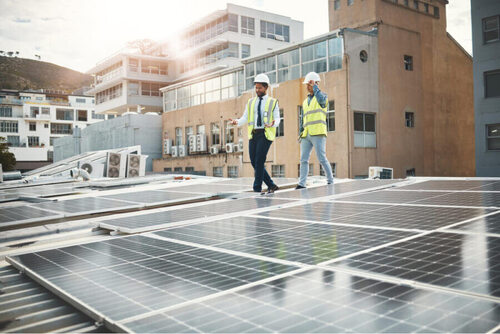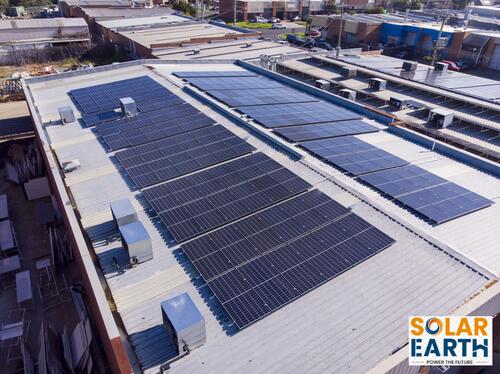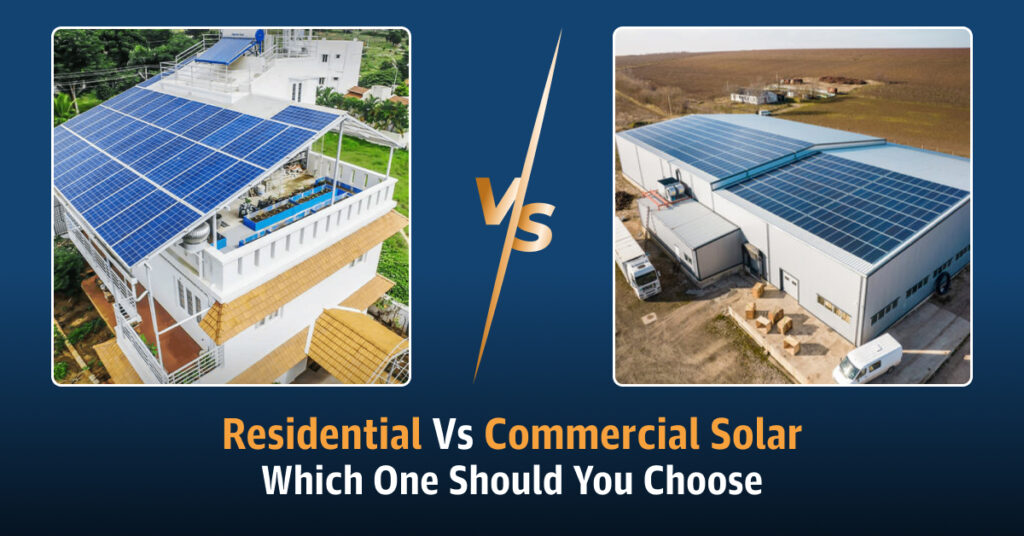The commercial solar market in India is rapidly expanding, driven by significant corporate adoption seeking cost savings and a reduced carbon footprint. There is a notable trend towards incorporating advanced technologies like high-efficiency panels and integrated energy storage systems to ensure consistent power supply for industrial operations.
Policy support, particularly initiatives aimed at bolstering domestic manufacturing through schemes like the Production Linked Incentive (PLI), is accelerating the sector’s growth and reducing import reliance. Regulators are exploring innovative business models such as virtual net metering and peer-to-peer trading to unlock potential for smaller enterprises, especially MSMEs, who represent a large untapped market.
Emerging Trends of Commercial Solar Systems in India
-
The Rising Solar System Wave in India
India is on the edge of an energy revolution, and commercial solar systems are at the centre of this alteration. Over the past decade, solar energy acceptance amongst industries, institutions, and commercial complexes has grown exponentially. With increasing electricity costs, sustainability goals, and helpful government initiatives, the trends of commercial solar systems in India have become a crucial point for the renewable energy sector.
As of 2025, India has accomplished over 82 GW of solar capacity, with commercial and industrial sectors contributing suggestively. Businesses are now viewing solar installations not just as a cost-saving mechanism but as a long-term investment in sustainability and energy freedom.
-
Government Policies Fueling Commercial Solar Growth
The Indian government’s hands-on stance toward renewable energy has been involved in driving the commercial solar sector forward.
2.1 Solar Energy Targets and National Missions
Under the National Solar Mission, India’s goals are to reach 280 GW of solar capacity by 2030. This comprises widespread contributions from commercial and industrial consumers. The “Green Open Access Rules 2022” have made it easier for businesses to obtain solar energy straight, further dipping dependence on grid power.
2.2 Incentives, Subsidies, and Tax Benefits
The government proposes plentiful incentives such as Accelerated Depreciation (AD), GST exemptions, and Viability Gap Funding (VGF). Commercial users can claim tax benefits on solar installations, making them an attractive investment. These financial levers endure to quicken acceptance across corporate sectors, chiefly in manufacturing, hospitality, and IT.

-
Declining Costs and Higher ROI for Businesses
One of the most perceptible trends in India’s commercial solar sector is the rapid fall in solar panel costs. Prices have dropped nearly 85% in the past decade, driven by technological invention and mass production.
Today, commercial solar systems propose a payback period of just 3–5 years, and businesses can relish over 20 years of free electricity after that. Companies like Tata Power Solar and Waaree Energies are making high-efficiency panels obtainable at modest rates.
The ROI of solar investments has become even more attractive as corporate electricity tariffs endure to increase yearly by 5–7%.
-
Technology Advancements in Commercial Solar Panels
The solar industry is experiencing a huge technological shift. Modern systems are not only more well-organised but also cleverer and easier to uphold.
4.1 Bifacial and Half-Cut Cell Technology
Bifacial panels can produce electricity from both sides, cumulative energy yield by up to 20%. Likewise, half-cut cell panels decrease repellent losses, offering enhanced performance in high-temperature environments like India.
4.2 AI and IoT Integration in Solar Systems
Smart solar monitoring systems powered by AI and IoT permit real-time performance tracking and projecting upkeep. These innovations improve operational competence, decrease downtime, and safeguard that commercial setups preserve ideal output.
-
Battery Storage and Hybrid Solar Solutions
Energy storage is becoming a game-changer. With battery prices falling and technologies like lithium-ion and flow batteries maturing, hybrid solar systems are emerging as the preferred selection.
Commercial units are positioning solar + battery solutions to confirm continuous power during grid outages and to optimize highest load management. This tendency is expressly appropriate for sectors like healthcare, data centers, and manufacturing, where energy reliability is critical.
-
Solar-as-a-Service and PPA Models Gaining Popularity
Businesses hesitant to invest upfront are embracing Power Purchase Agreements (PPAs) and Solar-as-a-Service (SaaS) models. Under these setups, third-party developers install and maintain the systems, while the company pays only for the energy consumed.
This model eradicates capital expenditure and working burdens, making solar power reachable to SMEs and big corporations alike.

-
Rooftop and On-Site Commercial Installations
Rooftop solar installations are an increasing trend, particularly in metropolitan areas like Delhi, Mumbai, and Bangalore. With space optimization and modular design, even small rooftops can host effective systems.
On-site solar farms, installed adjacent to commercial facilities, are also gaining thrust as businesses seek to maximize control over energy generation.
-
Role of Corporate Sustainability and ESG Goals
Sustainability is no longer elective, it’s a business authoritative. Companies are aligning with worldwide ESG (Environmental, Social, and Governance) frameworks, using solar acceptance as a quantifiable sustainability metric.
Businesses such as Infosys, Mahindra, and ITC are leading by example, integrating solar energy into their long-term sustainability roadmaps.
-
Growth of Solar Parks and Large-Scale Commercial Projects
Solar parks offer an effectual, large-scale tactic for commercial users to invest in renewable energy. States like Rajasthan, Gujarat, and Karnataka have become hotspots for solar parks, offering stable policies and vast land availability.
Numerous corporate buyers are now partnering with developers through open access models, sourcing clean power from these big facilities.
-
Challenges and Opportunities in India’s Commercial Solar Market
Despite huge progress, a few bottlenecks continue in scaling solar adoption.
10.1 Grid Integration and Transmission Bottlenecks
The grid infrastructure in convinced regions still lags behind, leading to curtailment issues and transmission losses.
10.2 Financing and Regulatory Challenges
While financing has enhanced, SMEs frequently face challenges accessing inexpensive capital. An unbroken policy framework across states could further quicken growth.
-
Future Outlook: The Next Decade of Solar Power in India
By 2035, India’s commercial solar landscape will be marked by grid-interactive systems, AI-driven energy management, and prevalent EV integration.
With sustained R&D, promising policy frameworks, and technological progress, India is well-positioned to become a global leader in commercial solar adoption.
FAQs on Commercial Solar Systems in India
- What is the average cost of a commercial solar system in India?
The average cost ranges between ₹35–₹45 per watt, depending on capacity, brand, and technology used. - How long does a commercial solar system last?
Most systems come with a 25-year performance warranty and can last over 30 years with proper maintenance. - Is solar energy reliable for industrial operations?
Yes. With hybrid and battery-backed systems, industries can achieve a consistent power supply and reduce dependency on the grid. - What are the main benefits for businesses adopting solar?
Reduced operational costs, tax savings, lower carbon footprint, and improved ESG ratings. - Can solar power be integrated with existing grid connections?
Absolutely. Commercial solar setups can be either grid-tied, off-grid, or hybrid, depending on business requirements. - What incentives are available for commercial solar users in India?
Accelerated depreciation, net metering, and open-access energy policies are the top incentives driving adoption.
Conclusion: A Brighter Future Powered by the Sun
The trends of commercial solar systems in India clearly establish a shift toward clean, affordable, and sustainable energy. With quick advancements, policy support, and business contribution, India’s commercial solar voyage has only just begun. Companies that invest in solar today are not just saving costs, they’re securing a future powered by innovation and responsibility.



